The days are growing longer, the birds are singing, flowers are blooming. Spring is here! And with these harbingers come the added responsibility of making one’s vessel fit to launch for the upcoming spring commissioning season, which will soon be afoot. The anticipation that spring brings provides the inspiration, before winter has been relinquished for good, to dedicate long hours to the improvement of one’s vessel so that the upcoming season will be a smashing success.
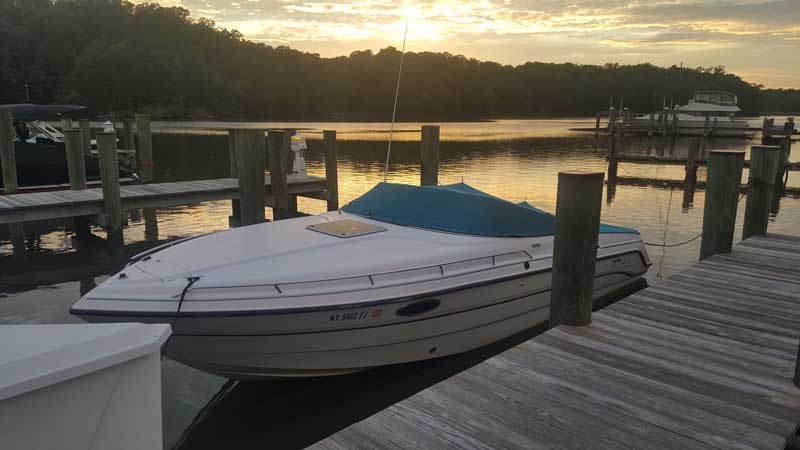
Step One: Finish/complete annual maintenance.
With the boating season looming but not yet here, spring provides the opportunity to complete annual maintenance that may have been brushed off at winterization. This is the time to ensure things like oil and filter changes, gear case oil changes, fuel filter changes, greasing of pivot points, tightening of gimbal ring bolts, etc. are completed for the 2024 season if they have not been already. It is also the time to check and verify the condition of all other fluids like power steering, hydraulic steering, trim/tilt, and transmission fluid. Any milky or burnt fluids should be replaced and if milky, the leaking seal should be found and dealt with before the upcoming season.
Step Two: Check… EVERYTHING.
Boats break while sitting, just as much as they do while being used. And so, at the beginning of the season, a careful and thoughtful owner should go through his or her vessel and inspect as much as they can. If you have a modern outboard-powered vessel, pay close attention to the fuel system and drain any fuel/water separating canisters—and also replace the engine-mounted fuel filters for peace of mind. If you have a sterndrive, thoroughly inspect all bellows, trim hoses, gear lube hoses (if a Mercruiser), and anodes: if any part is suspect, beyond its useful life, or showing early signs of failure, replacement is necessary. If you have an inboard-powered vessel, inspect struts, bearings, and packing glands (although this last item is easier done in the water before haul out). On larger vessels, seacocks should be operated and lubricated as specified by their manufacturer.
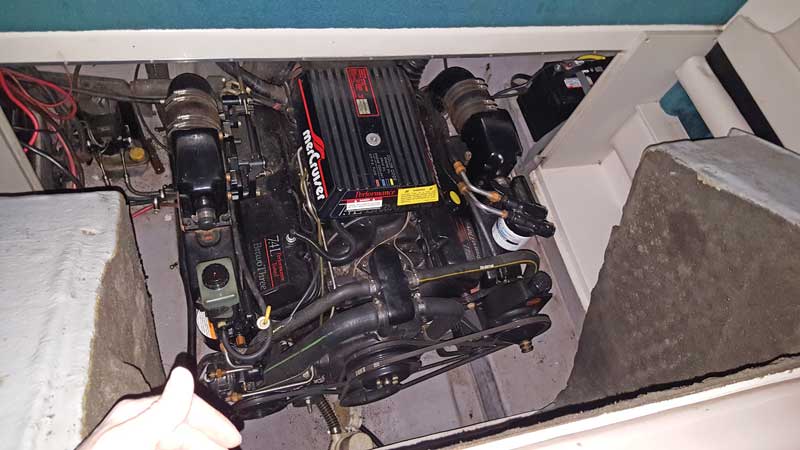
Special care should also be paid to the vessel’s engine(s) and machinery, so I recommend testing everything on land with a hose before launch because haul-outs are not cheap. What one should look and listen for are any odd noises, leaks, smells, etc. Temperature readings of exhaust components like manifolds, risers, Y-pipes, and mufflers, should also be taken and considered. Generally, if it is too hot to hold your hand on it indefinitely at a high idle speed not under load, there is a problem, and these parts should be disassembled for further investigation.
Similarly, electronics and electrical systems should be tested to ensure operation: on a boat, nothing should be thought of as a given or assumed. Batteries should be charged with a marine-rated, ignition-protected battery charger (preferably permanently installed) if they haven’t been charged all winter. Cockpit, cabin, and navigation lights should be switched on to ensure function. Pressurized freshwater systems should be operated and tested at every faucet or hose and tested to ensure water pressure, as well as to verify the absence of leaks behind furniture or into the bilge. Battery electrolyte levels should be checked (if wet-cell) and adjusted with distilled water as needed. Outlets, fridges, ranges, etc. should be tested and cleaned/repaired as needed, for many owners are greeted by an unpleasant and odiferous surprise in their vessel’s fridge or oven come springtime!
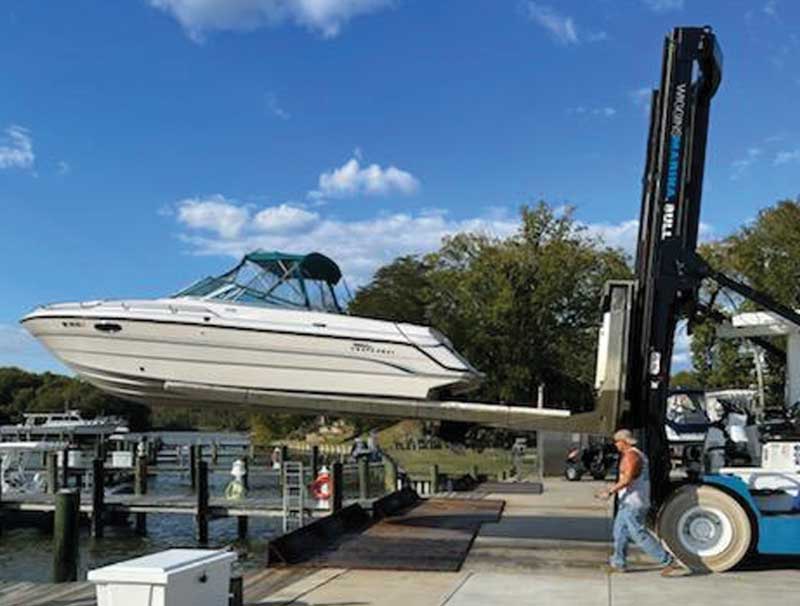
Ground tackle and electric windlasses should also be lubricated and tested. Cleats and stanchions should be kicked and yanked to ensure they remain tight and true. Canvas should be fitted and inspected. Propellers should be removed and greased—and propeller shafts should be checked for play or warping.
I think at this point you get the point, and I rest my case.
Step Three: Schedule/complete repairs.
At this stage, assuming you are thorough in your inspection, I am sure you will have a list of necessary tasks and repairs to complete before launching, as all boats new and old do. It is at this point one should prioritize tasks based on necessity and preference into a hierarchy. Tasks which cannot be completed by DIY means should be outsourced to one of the many trustworthy shops in the area. As an operator of a small, local, and personally tailored marine repair, consulting, and surveying business, heed my advice: it is best to schedule repairs as soon as possible, because come summer, shops become inundated with work and have little capacity to perform larger repairs (if needed). In the height of the season, it is typical to be backlogged six to eight weeks, while winter, fall, and spring will be one to two weeks in most cases.
Once larger, more complex tasks are scheduled to be hired out, it is time to DIY those repairs, maintenance-tasks, and upgrades that are applicable. Through this approach, your vessel will gradually become ready for the season, bit by bit.
Step Four: CLEAN… EVERYTHING!
The beginning of a new season presents a good opportunity to go through and do a thorough, annual cleaning of all things. Assuming a gel coated exterior, this is the time to apply (or have applied) a polish or ceramic coating—after buffing with rubbing compound if needed. For this task, I prefer Shurrhold Buff Magic and Pro Polish, which I’ve used for years with good results on my older boat, as well as clients’ boats. In Maryland, applying Pro Polish is typically a bi-annual affair for uncovered vessels. For smooth fiberglass surfaces inside lockers or the cockpit, a spray on/wipe off speed detailer with UV inhibitors by Boat Bling or 303 is a safe bet.
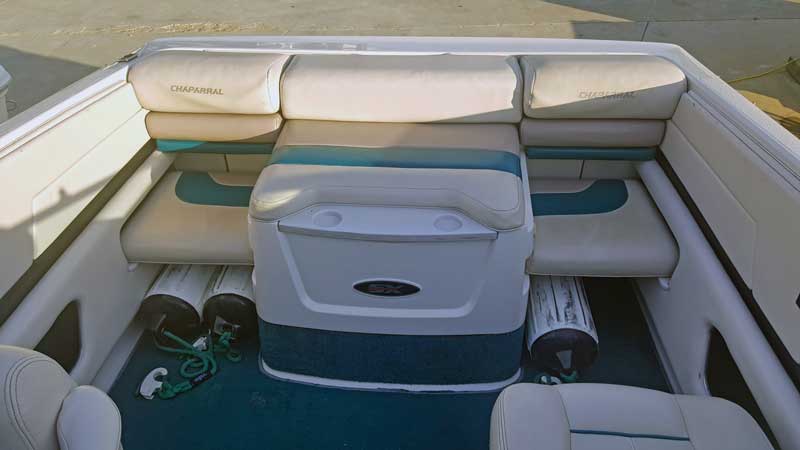
After the fiberglass is taken care of, it’s time to proceed to cleaning the vinyl and there are many ways to do this. Simple Green or a Starbrite vinyl/mildew removing product followed by 303 Aerospace Protectant scrubbed on via a slightly abrasive sponge are my usual go-to products. Take care to avoid damaging seams and do not use magic erasers, as they erode the protective coating of vinyl and exacerbate pinking, mildew, rips/tears, and fading over time.
Once the vinyl and fiberglass have been polished, it is time to scrub the non-skid deck, which unfortunately will be a reoccurring maintenance task. For this, I like Starbrite’s non-skid cleaners and polish, which help keep non-skid reasonably clean. A pressure washer also works wonders on non-stained, non-skid surfaces that are simply dirty. After cleaning the decks, I proceed to vacuum the cabin and clean surfaces, cushions, and headliners as needed. Methods will vary greatly depending on the types of soft materials used, but steam cleaning works wonders on soiled carpets and cloth headliners. Once the cabin is cleaned, the canvas should be cleaned and waterproofed as needed. There are specific products that work well on isinglass windows, in addition to a great product made by Starbrite for waterproofing Sunbrella canvas and aging and leaky, polyester boat covers.
Step Five: Inspect your trailer and complete necessary maintenance.
Step five only applies to trailered boats but is nonetheless incredibly important and often neglected. Trailers require much maintenance to their bearings, leaf springs, bunks, lights, and brakes and the intervals will vary depending on use, exposure to the elements, as well as whether or not the trailer is dipped frequently in salt/brackish water. In general, if you cannot remember the last time your trailer bearings were replaced or greased, replace them this spring as cheap insurance. Saving $100-$200 is not worth the risk of a wheel heating up and flying off on the highway! Leaf springs will typically look ghastly with rust before they are dangerous, but brakes can seize up without any discernible warning, thereby causing a bearing failure. Thus, it is advisable to check brake actuation and pads before every season, in addition to ensuring that the fluid is clean.
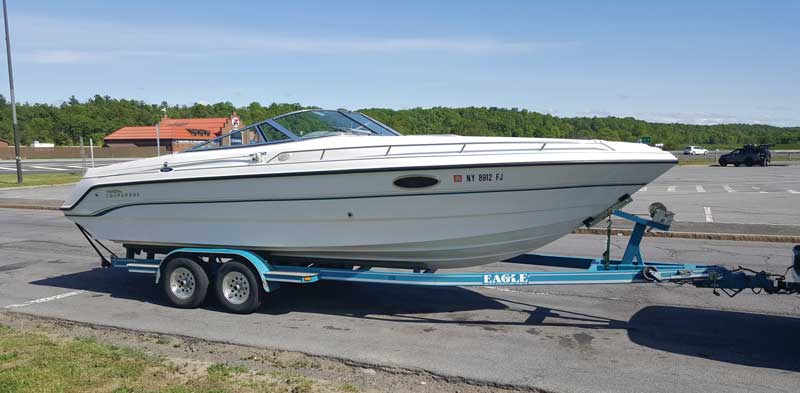
If you follow these five steps, you will greatly increase your chances of a successful and trouble-free boating season in 2024!
By Drew Maglio